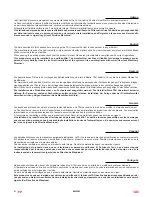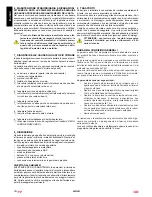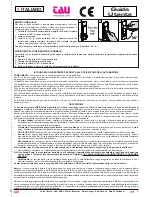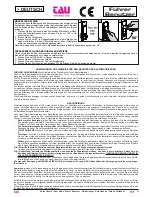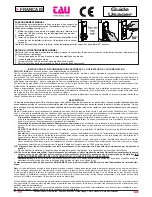
LUXE
13
ENGLISH
3.3_ Typical system (pic. # 11)
1 Luxe cabinet
2 Control panel
3 Aluminium bar
4 LED strip
5 Bar gasket
6 LED display
7 Aerial
8 Photocell pillar
9 Photocells
10 Photocell side support
11 Bar rest (fixed)
12 Metal mass sensor
3.4_ Automation base preparation
Wall the foundation plate so that the barrier door and
the releasing handle are easy to access.
Create a rectangular, suitably sized floor slab (A pic. # 3) with the
holes for the exiting cables. Use the foundation counterplate (B
pic. # 3), with the 4 anchors supplied to be buried in concrete; or,
once the floor slab is completed, fix the cabinet to the barrier with
4 M10x120 foundation plugs (C pic. # 3). The slab thickness must
be at least 10cm and can be increased as required.
3.5_ Installation of the barrier group
Without bar and springs, the barrier must be positioned as follows:
- remove nuts and washers from the protruding bolts, position
the cabinet on the base and fix it. Check it is anchored securely
and correct if necessary.
Note: it is advisable to install the cabinet with the door on the side
more easily accessible.
- Open the door with the relative key and remove.
LUXE is normally delivered RIGHT (RH), with the bar support in a
horizontal
position.
Right-hand barriers (RH) are barriers that have
the cabinet on the right-hand side viewed from the inside of the
passageway (the door is normally on the inside). If it is necessary
for it to be LEFT (LH), the opening must be inverted.
Proceed as follows:
1_ after removing the eye screws and the circlips, take the pins
and reposition them, symmetrically, on the opposite side of the
drilled beam (pic. # 4A), fix with the circlips and screw the
screws in again;
2_ after removing the locking screw and washer, remove the bar
balancing lever. In the spring supporting group, invert the posi
-
tion of the pin (1 pic. # 4B), rotate the whole block by 180° (in
respect of the previous position) and fix the motor shaft again
with bolt and washer (pic. # 4C);
3_ once the opening direction has been modified, invert the motor
connections (see K206MA instructions).
The drilled beam allows to determine different maxi-
mum loads (in relation to the length of the bar and ac-
cessories applied) in the various positions (the nearer
to the vertical, the lower the maximum load).
Once the opening direction is modified, the positioning
of the devices must be inverted.
If the barrier must be modified from LH to RH, the operations are
the same.
3.6_ Bar fixing, spring fitting and bar balancing
All operations must be carried out with the power OFF.
After releasing the automation (see the “Manual release” chapter),
proceed as follows:
1_ using a support, bring the bar in the horizontal position (wholly
assembled and with all the accessories) near the bar support
and fix with the omega bracket and the screws supplied (pic. #
5A);
Note: the bar must be inserted for the whole length of the ome-
ga bracket.
2_ when the omega bracket is fixed, and after removing the pro
-
tective cap, pass the LED cable through the hole on the cabinet
(to take the cable to the control unit, refer to figure 9) then fit the
cover and secure it with the screws supplied (pic. # 5B);
3_ place the bar in a vertical position and block the gearmotor (see
the “Manual release” chapter).
Fit the springs hooking them to the eye screws and rotate manually
in the direction of the arrow for the first preload (pic. # 5C).
Continue with bar balancing.
Before balancing the bar check on the table on page 4
the chosen spring, accessories to be applied and dis-
tance are adequate. Correct balancing is vital for the
barrier to work properly.
This operation must be carried out only when the bar has
been installed permanently with all its accessories.
pic. # 6: operate the manual release (see the “Manual release”
chapter) keeping at a safe distance. The bar must move
to 30° on its own, if that is not the case load/unload the
springs (if the bar lifts above 30° the springs need to
be unloaded, that is they have to be rotated manually
in an anticlockwise direction, if it does not reach 30°,
the springs must be loaded, that is rotated manually in
a clockwise direction). Lower the bar and release it,
checking it has reached 30°.
For the barrier to work correctly, when loading/unload-
ing the springs, keep the same protrusion for the eye
screws (pic. # 5C).
Continue with the electrical connections to the control panel (see
the chapter on electrical connections).
Note: check the spring works correctly.
IMPORTANT! For a correct operation of the barrier,
when the boom is in vertical position the springs must
not be completely unloaded.
3.7_ Manual release
WARNING! Releasing and any other manual operation
must be carried out only with the bar fitted. It is abso-
lutely forbidden to operate the barrier without the bar
fitted.
1_ Insert the key into the handle lock on the back of the cabinet
and rotate by 180° in an anticlockwise direction (pic. # 7A);
2_ take the handle out and rotate by 90° in an anticlockwise direc
-
tion to release the bar (if it seems to resist, apply more strength
onto the handle since this will cause no breakage), pic. # 7B.
When released, the bar must automatically go to the balance
position (ca. 30°).
WARNING! Releasing can be potentially dangerous for
the user when for any reason whatsoever (bar badly
fitted during installation, bar broken due to an acci-
dent, etc.) the springs do not guarantee balancing any
longer!
They can cause the bar coupling and/or the bar itself to
rotate suddenly.
3.8_ Stop adjustment
The barrier is normally supplied with the stops already adjusted for
perfect travel.
If the plate has not been cemented properly, the bar might not be
perfectly horizontal or vertical and the installation might not be suc
-
cessful from an aesthetic point of view.
To correct the vertical position (=opening), close the bar, open the
door and rotate the free stopper (1 pic. # 8) in a clockwise (to in
-
crease the bar travel) or anticlockwise direction (to reduce the bar
travel).
Similarly, to correct the horizontal position (=closing), open the bar
and adjust the free stopper (2 pic. # 8).
After checking and adjusting the bar opening and closing opera
-
tion, tighten the locknuts under the stoppers.
Whenever the position of the mechanical stops is mod-
ified, the saving procedure on the control card must be
performed (see K206MA instructions).


